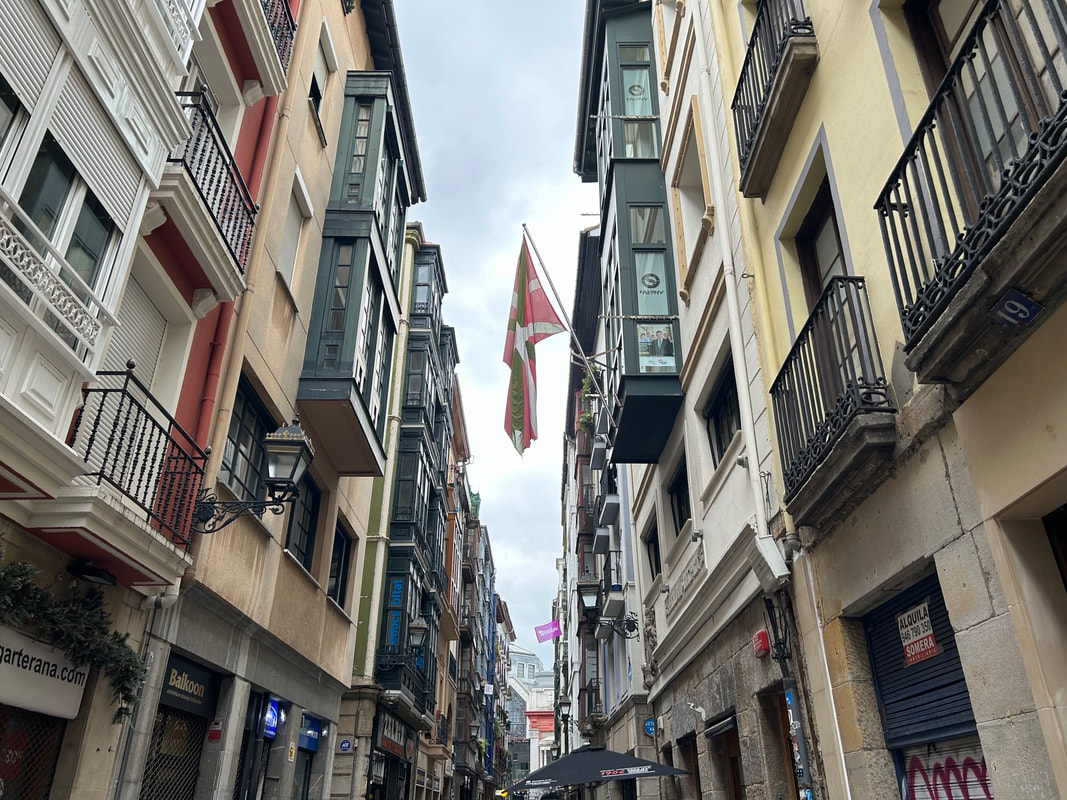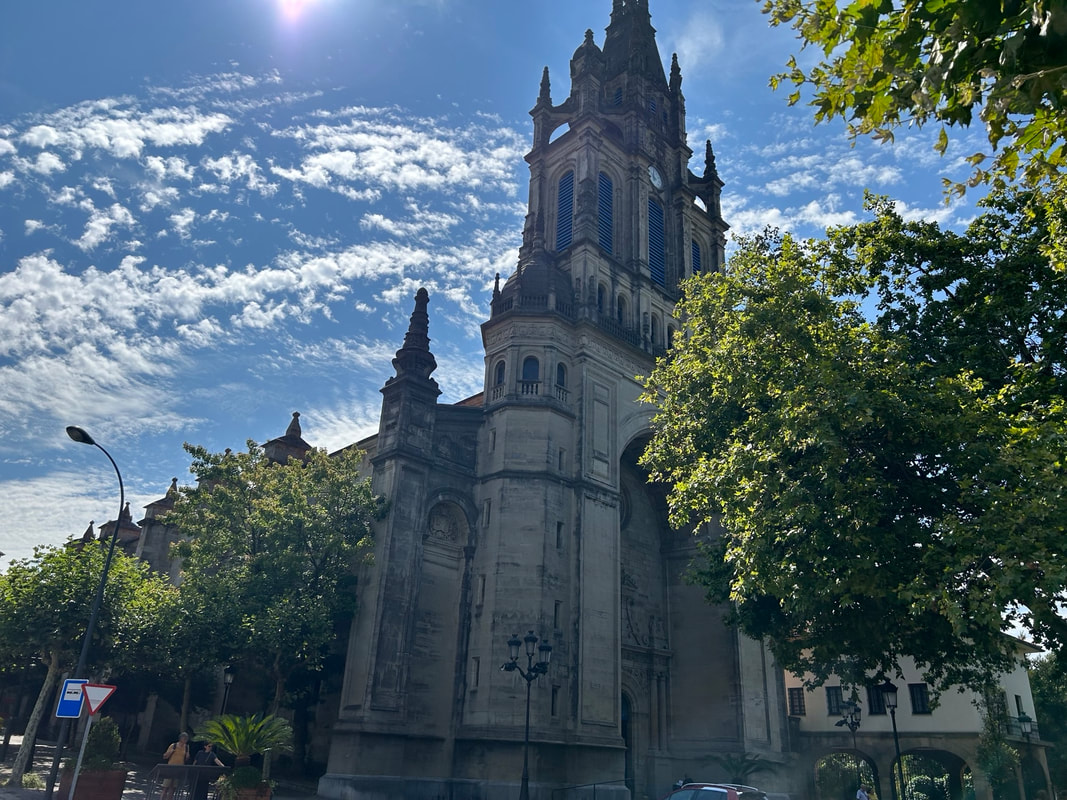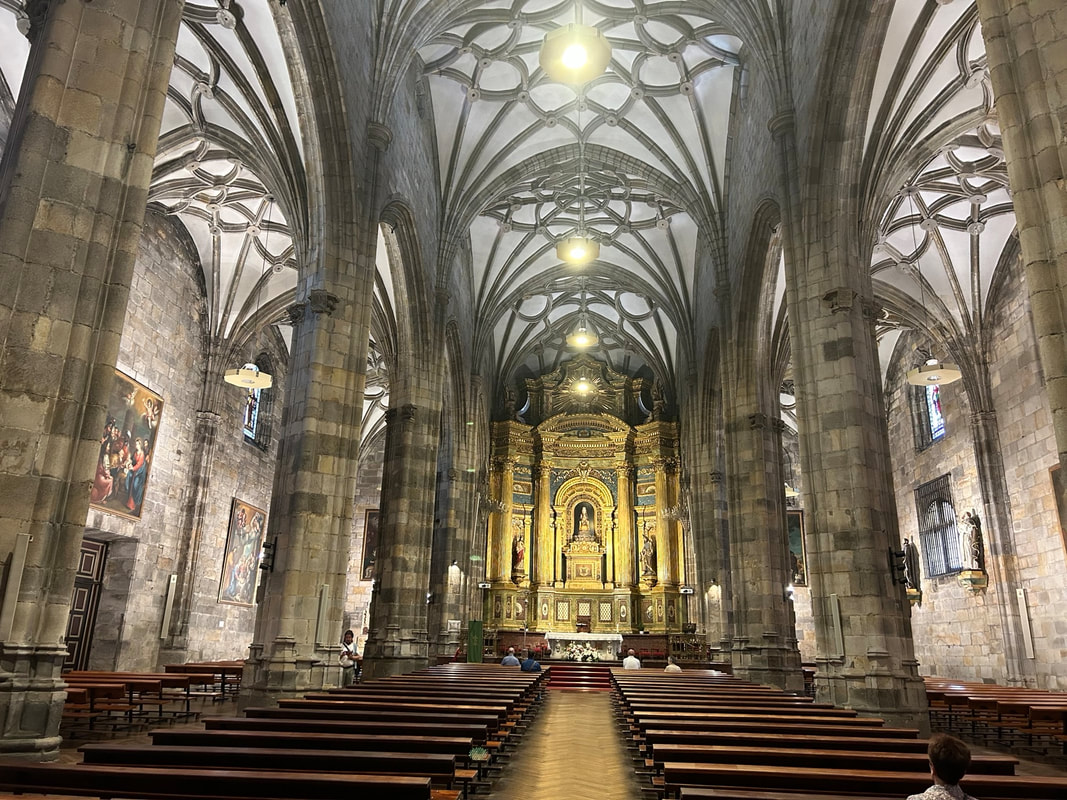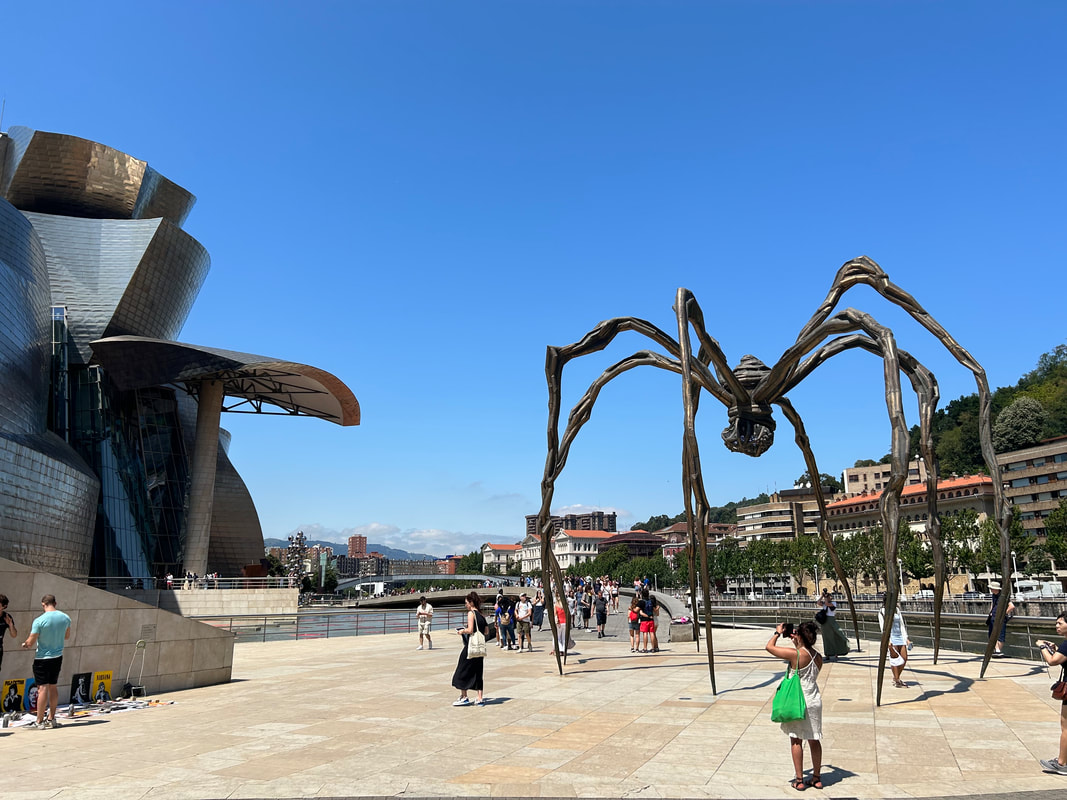SummaryAirport Rating ***** Reception of locals ***** Cost: £££
Euskal HerriaThe history of the Basque Country and Bilbao is a complex tapestry, interwoven with centuries of tradition, cultural diversity, and political turbulence. The Basque Country, or Euskal Herria in the Basque language, is an ancient region located in the Pyrenees Mountains straddling modern-day Spain and France. The Basques are known for their distinct language, Euskara, which remains one of the few pre-Indo-European languages in Europe. The origins of the Basque people and their language remain a subject of intrigue among linguists and historians and it's a topic I find personally fascinating. I'm a strong believer in self-determination where it has the support of a majority of the population. In a best-case scenario, a region can achieve independence, but even if it falls several steps short, it can still win a form of autonomy that secures protection for its people, culture, language, and religion. The Basque Country is a region that is fiercely independent and independence movements here have traditionally secured a high degree of support from the local population, much like Panjab. Activists led resistance against the centralised control of Spain for many decades, particularly through the period of fascist rule of Franco where local languages and culture were severely repressed. At times, the movement for freedom spilled into violence, with ETA, a Basque nationalist militant group active throughout the second half of the 20th century. Although the Basques have not secured independence, they have gained a significant form of autonomy not enjoyed by any other region in Spain (not even Catalonia). This hard-won autonomy ensures protection of the local language and culture and enjoys broad support from the population which has resulted in armed militants laying down their weapons. It's an outcome that many Panjabi leaders have fought for in the past half century too. Today, the push for complete independence continues to exist, although it is tempered by the unique position the Basque country finds itself in, particularly the fact that it collects its own taxes, rather than Spain. You can see still the Basque nationalist flag flying across balconies and buildings throughout Bilbao and many street and shop signs are in both Spanish and the Euskara. Throughout history, the Basque Country has been home to various tribes and small kingdoms. It was an area of strategic importance due to its proximity to the Bay of Biscay, making it a hub for maritime trade. The Basques were skilled sailors and fishermen, and their culture was deeply intertwined with the sea. Bilbao, the largest city in the Basque Country, has a history that can be traced back to the 14th century. It initially grew as a trading port, thanks to its advantageous location along the Nervion River. By the 16th century, Bilbao had become a thriving commercial centre, primarily engaged in shipbuilding, mining, and ironworks. The industrial revolution in the 19th century brought about significant changes to Bilbao and the Basque Country. The city became a powerhouse of steel production, thanks to the discovery of rich iron ore deposits in the nearby mountains. The transformation was remarkable, and the region's economic prosperity attracted labourers from across Spain and beyond. However, the 20th century brought challenges and political upheaval. The Basque Country, like other regions in Spain, faced the Spanish Civil War (1936-1939) and the subsequent Franco dictatorship. The Basque culture and language were suppressed during this period, leading to cultural resistance. In the post-Franco era, the Basque Country experienced significant political changes. The Basque nationalist movement sought greater autonomy and cultural recognition. This movement led to the establishment of the Basque Autonomous Community in 1979, granting the region a degree of self-governance. Bilbao underwent a remarkable transformation in the late 20th century, driven by urban renewal and cultural initiatives. The construction of the iconic Guggenheim Museum Bilbao in 1997 became a symbol of the city's renaissance. Today, the Basque Country and Bilbao are known for their unique blend of tradition and modernity. The Basque language and culture have experienced a resurgence, and the region enjoys a degree of autonomy within Spain. Bilbao, with its stunning architecture, thriving arts scene, and culinary delights, continues to attract visitors from around the world, contributing to the rich history and dynamic present of the Basque Country. The city has a modern and extensive transport network and rides on their tram system and metro are cheap, convenient and straightforward to use. The Old TownThe beating heart of Bilbao is the old town, known as Casco Viejo, a beautiful - although small - neighbourhood that is filled with a tremendous amount of history. The area is a living museum of architectural styles spanning centuries. As you wander through its narrow streets, you'll encounter a captivating mix of Gothic, Renaissance, and Baroque structures. Given the largely industrial nature of the rest of the city, the old town really stands out and the dichotomy makes it possibly more beautiful than it might have been without the contrast to the areas outside. The central area of Casco Viejo is known as the Seven Streets. These are the seven streets that make up the oldest section of the old town which over the centuries has expanded to around fourteen streets and several new squares. Casco Viejo is steeped in history, and its landmarks reflect this. The Santiago Cathedral, dating back to the 14th century, stands as a symbol of the city's religious heritage. The Mercado de la Ribera, one of Europe's largest indoor markets, showcases a bustling atmosphere where locals have shopped for generations. The Old Town also boasts a thriving contemporary arts scene. Art galleries and studios dot the area, showcasing the talents of both local and international artists. There are incredible cafes and bakeries, ice cream parlours that are as nice as any in the country, and gorgeous buildings everywhere you look. As the sun sets, Casco Viejo comes to life with a buzzing nightlife scene, with people spilling out onto the streets and enjoying life in a way that we don't seem to do in the UK (not that our weather would allow us anyway). It's a beautiful feeling to be around. This was the area where I spent most of my three days in the city. During the first couple of days, I found myself lost in the maze of the city, its layout feels like the neighbourhood is constantly shifting around you. By the final day I had broadly got my bearings, but the place feels so different between night and day that you would swear they were two different neighbourhoods entirely. Churches and cathedralsBilbao, just like the rest of Spain, loves a good cathedral, and you can throw in churches and basilicas too. There are numerous churches throughout the city, but three stand out. Undoubtedly, the most important building in the old town is the Catedral de Santiago, dedicated to Saint James the Apostle. Built during the 14th and 15th centuries, it exhibits an impressive blend of architectural styles, including Gothic, Renaissance, and Baroque elements. The cathedral's interior is equally captivating, featuring a stunning nave and a remarkable retablo, or altarpiece, dedicated to Santiago. The Catedral de Santiago is a testament to the city's rich religious heritage and architectural prowess, and while it isn't the most impressive cathedral in Spain, it is still incredibly beautiful. A short walk from the cathedral is the Iglesia de San Nicolás, dedicated to Saint Nicholas of Bari, another architectural gem nestled in the heart of Bilbao's Old Town. Constructed during the 18th century, it embodies the opulence of the Baroque period, both in its architectural features and interior decorations. Inside the church, there is a lavish altarpiece adorned with intricate woodwork and gilded detailing. The stunning frescoes and paintings that adorn the walls and ceilings add to the church's visual splendor. Iglesia de San Nicolás remains a place of worship and a cultural landmark, offering a glimpse into the city's religious and artistic heritage. A little further out, is the Basilica de Begoña, perched atop a hill overlooking Bilbao. Dedicated to the Virgin of Begoña, the patron saint of Biscay, this basilica has a history dating back to the 16th century. Its architectural style is predominantly Gothic, with elements of Baroque and Neoclassical influence. The basilica's location affords breathtaking panoramic views of Bilbao and the surrounding countryside. The main altarpiece, exquisite stained-glass windows, and a revered image of the Virgin of Begoña are among the basilica's notable features. Plazas and PintxosSpanish cities are known for their beautiful squares, or 'plazas' and Bilbao is no different with numerous plazas dotting the city centre. The largest of these squares is the Plaza Nueva, also known as Plaza Barria in the Basque language, an enchanting square situated in the heart of Bilbao's Old Town. Plaza Nueva is an example of 19th-century urban design in the neoclassical style. The square is framed by colourful buildings, and its central courtyard hosts a weekly market. It was the first square that I visited, and also became the anchor whenever I'd get lost in the old town. For me, the highlight of the square and surrounding old town area, is the myriad of cafes and restaurants selling 'Pintxos'. These are often referred to as "pinchos" in other parts of Spain, are synonymous with Basque cuisine. I'm not a bigtime food person - for me it is just fuel and energy - but these little bites were so addictive. They're similar to tapas that you get elsewhere in Spain but they are almost all served on a little piece of bread. Pintxos come in a variety of forms, from simple skewered combinations of olives and cheese to more complex creations featuring seafood, cured meats, and vegetables. What sets pintxos apart is not only their delicious flavours but also their artistic presentation. Each bar in Bilbao's Old Town competes to display the most enticing assortment of pintxos on their counters, making it a visual feast for patrons. There were a couple that I absolutely loved - Cafe Bilbao, and Bacaicoa Taberna - the second was particularly welcoming! Sampling pintxos is more than just a meal; it's a cherished social ritual. Locals often meet friends and family at pintxos bars to share conversation and culinary delights. The best way to explore the world of pintxos in Bilbao is to embark on a "pintxos crawl," moving from one bar to another, trying the specialties at each establishment. This culinary adventure allows you to discover the diverse flavours and unique recipes that make pintxos a culinary treasure in the Basque Country. I can't tell you how much I enjoyed doing this in the evenings, and it was comfortably the best part of my Basque experience. It's one thing that I've thought about often since leaving the city. Stairway to heavenA short walk from the Basílica de Begoña is Etxebarria Parkea, nestled on the slopes overlooking Bilbao's historic Casco Viejo. It's an urban park and in of itself is nothing special, but the thing that makes this unique is the journey down the hill to the old town. The descent is not merely a physical journey but a sensory and visual experience. As you descend, the cityscape unfolds before you, revealing the red-tiled roofs, narrow alleyways, and centuries-old buildings that define Casco Viejo's unique character. In many ways, it reminded me of the walk down to the city from the San Martino neighbourhood in Naples, with glimpses of the cityscape turning into being in the middle of the old town. The stairs themselves are an integral part of this journey. They are adorned with artistic murals, sculptures, and floral displays, creating a dynamic and aesthetically pleasing pathway. The art installations along the way pay homage to the city's cultural heritage and offer a visual narrative of Bilbao's history. Descending the stairs into Casco Viejo is like stepping back in time. The transition from the serene greenery of Etxebarria Parkea to the vibrant, historical streets of the Old Town is a seamless experience and seeing the skyline open up ahead of me was an experience I won't soon forget. Mercado de la RiberaOne of my favourite parts of the culture of southern European countries is the availability of fresh food at reasonable prices in the centre of even the busiest cities. Even better, in many Spanish cities, this fresh food is often found in architectural beauties. Mercado de la Ribera, or Ribera Market, is no different. It is a vibrant and historic marketplace located in the heart of Bilbao and this bustling market has deep roots in the city's history, and it continues to play a pivotal role in the culinary and cultural fabric of Bilbao. Even today, it is the largest covered market in all of Europe. The market's origins can be traced back to the 14th century, making it one of Europe's oldest continuous indoor markets. Its location, nestled along the banks of the Nervion River, has made it a vital hub for trade and commerce throughout the centuries. The exterior of Mercado de la Ribera building is striking. Its neo-Mudejar architecture, featuring intricate tilework and an imposing facade, showcases a blend of Moorish and Gothic influences, reflecting the architectural diversity of Bilbao. One of the market's distinctive features is its impressive stained-glass window, a masterpiece that bathes the interior in a kaleidoscope of light and colours. Inside the market, you have stalls that sell an array of fresh and locally sourced produce, from fruits and vegetables to seafood and aromatic spices. Strolling through the market's bustling aisles is a sensory adventure - parts of it smell like beautiful spices and vegetables, others have an overwhelming smell of seafood and raw meat that can get a little much. Beyond its role as a place for buying and selling, the Mercado de la Ribera is a cultural institution. It serves as a meeting point for locals and in the evenings it's a great place to get some pintxos from the many small stalls in the food court. Conveniently, the market's close proximity to the historic Casco Viejo and the Arenal, Bilbao's waterfront area, makes it a convenient stop for those exploring the city's rich cultural and culinary offerings. More than just a train stationWhen it comes to beautiful stained-glass windows, there are not many more spectacular than Bilbao train station. Bilbao Abando, or Estación de Abando Indalecio Prieto in full, is the main railway station in Bilbao. It is a vital gateway connecting the city to various regions of Spain and beyond. The station's name pays tribute to Indalecio Prieto, a prominent Spanish politician hailing from Bilbao, who played a significant role during the turbulent years of the Spanish Republic and the Spanish Civil War. Abando Station's architecture reflects the city's modernity while preserving elements of historical charm. The main facade welcomes travellers with an elegant blend of neoclassical and modern design, showcasing grand columns and a central clock tower. Its distinctive red brickwork and white accents stand in contrast to the surrounding urban landscape. Inside the station, a bustling concourse unfolds, filled with passengers rushing to catch trains, buses, or the city's metro system. The station's connectivity is a key asset, making it a major transportation hub within Bilbao and the larger Basque region. Standing on the outside of the barriers but looking toward the train and outside the metallic hanger is a wonderful experience as you can see the colourful city in the distance. One of the most noteworthy features of Abando Station is its central hall, adorned with a soaring glass ceiling that bathes the space in natural light. This impressive architectural element adds a touch of grandeur to the station and creates an inviting ambiance for travelers. I'd almost missed it, only when I turned to leave and go down the escalators did I see it, and I'm so glad that I did. The Guggenheim... it's not that goodIf there is one building that represents Bilbao it is the Guggenheim Museum. You can think of it the same way as the Empire State Building in New York, the Eiffel Tower in Paris, or Elizabeth Tower in London. It's so well known that its silhouette is used on souvenirs around the city. Crafted by the eminent architect Frank Gehry, this museum has earned global recognition for its striking structural aesthetics, art collection, and its profound influence on the city of Bilbao since opening in 1997. The Guggenheim has been instrumental in rejuvenating the city. Prior to its establishment, Bilbao grappled with industrial decline and economic stagnation. Yet, the museum's arrival marked a turning point. Its construction drew international attention, leading to a surge in tourism and investments, catalysing urban revitalisation. The building is adorned with titanium panels and it transforms with the day's shifting light, creating a mesmerising spectacle. It stands out looking strikingly futuristic, just a short walk from the old town. Outside are several famous structures, from a large spider to a super-sized puppy. But that is where the positive comments end. It is a modern art museum, and as I've written previously, I don't understand modern art and the more I see the less I respect it. As bold and as creative the exterior is, the interior is not only forgettable, but to me it was offensively bad. There is the usual pointless "blank canvas" type of art (where you are essentially looking at nothing), then there are paintings that look as if they were done by 5-year-olds, and a small number of more interactive exhibitions (that are equally as bad). To me, going inside was a waste of time and money and unless you like / understand modern art, I would strongly recommend against it. That being said, there is no doubt the museum has transformed the city and put it on the cultural map, and for that alone, I would consider it job done. And it's not like I hate Guggenheim completely, I quite liked the one in New York. But then again, to me, museum and art galleries are just another way for rich people to avoid taxes by "donating" to have their names plastered over the building and exhibitions while stealing artefacts from around the world. Super San MamesIf you've read my blog, you'll know I love football and I've attended games and done stadium tours across several countries. The Estadio San Mamés, home of Athletic Bilbao, has been on my list for a long time as it is considered one of the best designed stadiums of the 2010s, winning several awards and is fairly well known outside of Spain. Architecturally, San Mamés Stadium is a striking sight. Its exterior boasts a distinctive design, characterised by the overlapping red and white panels that pay homage to the club's traditional colours. One of the things that sets Athletic Bilbao from other teams around the world is its unique player recruitment policy, which exclusively features athletes of Basque origin or heritage. This policy, known as "Cantera," is a source of pride for the club and the Basque community, emphasising local identity and tradition. Given that football clubs are supposed to be the pillar of local communities, this policy is more closely aligned to the traditional values of football clubs - far removed from the multimillion-pound mercenaries that scour the world for the best paydays. The stadium tour costs €15 and you can complete the self-guided tour in about an hour (with an audioguide you can access on your phone). There is very little off limits so it means you're able to go to the very edge of pitch, into the stands, the dressing rooms, the press room, and peer into some boxes. My favourite part of the whole tour is the museum that charts the rise of the football club, from British immigrants to a symbol of Basque nationalism. The museum presents early club kits, trophies, and stories of famous games. They even have a list of every player that has ever donned the famous red and white kit, a fantastic touch to pay homage to the players that made this club into a Basque institution. There are interactive exhibits, including a chance to practice penalty kicks! In terms of stadium tours that I have done, this ranks as one of the very best, and in terms of stadiums I have visited around the world, this would comfortably make the top half of any list I put together (and maybe I'll do just that in the future). City viewsOutside the main city centre is Artxanda Park, a small space of land situated atop Mount Artxanda which provides incredible views of the entire city of Bilbao. It's not a place you can easily walk to, and I drove to the top, leaving the car in a relatively small car park that gets quite busy. But there is an alternative and that is the funicular railway that connects the city to the park. The vista encompasses the city's urban landscape, the winding Nervion River, and the picturesque hills that cradle Bilbao. Across the city you can make out the old town, the Guggenheim Museum, Estadio San Mames, and the commercial and industrial districts. The views from Artxanda Park are spectacular and I'd strongly recommend visiting if you are in Bilbao. Would I recommend visiting Bilbao?Bilbao is comfortably one of my favourite cities in the Iberian Peninsula. It has everything you'd want from a major city - culture, architecture, good food, a nice vibe, plenty to see and do, and nice people who are incredibly welcoming. I'll be honest, there are not any Sikhs and actually not many brown people at all. On the face of it, it seems like a very culturally homogenous city, but the truth is in addition to local Basque culture, there is also sizeable influence from other cities from across Spain (particularly Galicia) and increasing immigration from South America too. The thing is, for once, it doesn't matter, because the people seemed very welcoming. Sure, some stared, the odd one or two intently, but on the whole the people smiled when they greeted me, were friendly and patient in the instances I didn't quite understand something, and whether in the day or the middle of the night, I never felt unsafe. Since coming back, I often crave pintxos, evening strolls in the old town, and nice walks along the river. If pining for a place is a measure of its impact, then Bilbao has been one of the most surprising and impactful cities of my travels. Comments are closed.
|
AuthorBritish Sikh, born in the Midlands, based in London, travelling the world seeing new cultures. Categories
All
|













 RSS Feed
RSS Feed